|
How I Became a Lancaster Lunatic
By Kay P. Caruso
It was the loveliest piece of glass I had ever seen, so I bought it. The tag
said, "Landrum, Lancaster." At that time, it had no meaning to me whatsoever. It
was just a really beautiful yellow glass tray with delicately scrolled handles,
which stood in a prominent place in my china cabinet.
I showed my treasured
piece to a friend who was knowledgeable about glass. "Do you think there are any
other pieces like this?" I queried. She told me about "The Bible" for glass
collectors, Colored Glassware of the Depression Era, Book 2 by Hazel Marie
Weatherman. I ordered it via the Internet and got it in a week. I ripped open
the box and quickly flipped to the "L" section to find the Lancaster pages. What
a surprise! Pages and pages of catalog reprints showing many pieces of glassware
made by Lancaster. Then, there it was Landrum. And yes, there were other
pieces, and they were made in three colors.
I will collect them all. This
will be my mission. That was about eight years ago. Since then, I've learned a
lot about "Landrum, Lancaster", and my house is filled with many exquisite and
interesting pieces made by the Lancaster Glass Company.
Shortly after my
discovery of the Weatherman book, my sister-in-law introduced me to eBay, and
the collecting fever got into full swing. I won't say I was addicted, but I had
to set up a system to keep track of the glass I was buying. In a few months, I
had collected most of the Landrum pieces, and decided in order to be a serious
collector of Lancaster, I would simply have to collect everything shown on the
catalog pages in the Weatherman book. I've pretty much achieved that goal and
then some, acquiring a collection of more than 350 pieces. I'm still collecting
and finding new and interesting pieces all the time.
Lancaster has several
identifying features that make it easy to recognize. The most prolific blank
used by the Lancaster Company was a gracefully scalloped blank with six points.
The Landrum pattern is an intricate floral pattern that was mold-etched onto
scalloped trays, plates, bowls, 3-toed bowls/trays and center-handled servers.
(The name Landrum was given to the pattern by H. Weatherman. The actual catalog
page did not indicate a name for this pattern). Many of these scalloped blanks
have a distinctive design in the center that looks like caning on a chair seat.
On the 3-toed pieces, there is a molded "petal" that leads into the toe. The rib
of the petal is actually a seam cleverly hidden in the design.
Another blank
that was widely used has three wide panels separated by three narrow ribbed
panels. It also has six scallops. Around the bottom of these pieces, there is a
twisted-cabled design. This blank was dubbed Cable Line by Gene Florence. The
most famous Cable piece, and a rare find, is the Sphinx pattern, which is a
winged Greek Sphinx design.
Some handle and toe designs are indicative of
Lancaster. Scroll handles with a scored curvy shape were used on all sizes of
bowls and trays and center-handled servers. They can be found on scalloped and
octagon pieces. The toes, or feet, on bowls and trays could be scrolled or
ribbed to look like vines. Crimping or pulling points downward and folding up
sides were techniques often used to create a variety of styles and eye-catching
shapes for marketing. A beautiful lace-edged pattern in clear and satin glass is
easily identified by the consistent size of the arched loops.
Lancaster
produced many types of decorations for their blanks. Glassware could be
satinized, reverse painted or adorned with hand-painted flowers and floral
decals. There are two different satin finishes. The hand-painted designs were
all very similar and usually had one or two central flowers with green stems and
leaves branching out from either side.
So far only two different floral
decals have been identified. A few mold-etched designs were done. Paneling
optics were used in a number of lines. In a few rare cases, gold edging and
silver overlay were used. Iridescent finishes in pearl and gold were used over
stretch glass in the early years.
The colors used by the company were not
always consistent. Pinks can range from pale to bright. Green can be from a true
lush green to a pale bluish or teal green. Yellow is the most consistent color.
Recently, two pieces of pale blue satin glass have turned up.
They also
produced lines in a jet black glass this is stunning. Early pieces were
exclusively crystal with ruby or gold flashing. Some crystal pieces with blank
shapes from the thirties have shown up.
The Lancaster Glass Company began in
1908 making clear pressed glass in Lancaster, Ohio, for general and
restaurant/hotel use. As preferences changed, Lancaster produced to meet the
needs of the consumer. In the twenties, the clear glass was reverse painted.
Their line used bright colors with wide black bands at the edges. At this time,
console sets were popular, and they produced many types. Lancaster letterheads
note that the company manufactured "high-grade table glassware, specialties and
novelties, plain and decorated."
Hocking took over controlling interest of
the Lancaster Glass Company in 1927. Lancaster continued to make and market
glass under the Lancaster name until 1937. After 1937, the factory was one of
the main Hocking producers and is still in use today.
Much of Lancaster's
glassware was sold undecorated to other glass companies or sent to Standard
Glass Company, another Hocking subsidiary, where wheel cutting was done. A
number of pieces of Lancaster glassware were purchased by the Canadian firm of
W.J. Hughes who specialized in cornflower cuttings. The Lotus catalog shows
pieces of Lancaster with Lotus decorations. At least three Lotus patterns were
applied to Lancaster pieces.
Lancaster glass is unlike other machine-made
glass of the Depression Era. It was not made in the mass-producing mold
machines. Most of it was mold blown and hand finished. Some collectors feel that
it should be classified as elegant glass due to its clarity and polished seams.
Defects can be found in some pieces, but the quality of the glass itself is
remarkable.
It is a unique company to collect because it is something
between the roughness of machine-made, mass-produced glass and the finer, more
expensive elegant glass. Because it is not labeled elegant glass at this time,
it is a very affordable to collect.
There are a number of books available besides the Weatherman book that
provide reliable information about the Lancaster Glass Company. The Measell and
Wiggins books Great American Glass of the Roaring 20s and the Depression Era
(Books 1& 2) have many colored photos of reversed-painted glass and show
advertising pages for the company.
Kay Caruso is a retired
teacher (33 years), and she has been collecting Depression Era glass for about
10 years. She specializes in collecting and researching Lancaster Glass. A
lifelong resident of the Greater New Orleans area, Kay has been a member of the
Crescent City Depression Glass Club for seven years and the National Depression
Glass Association. She is currently the editor of the CCDGS newsletter.
|
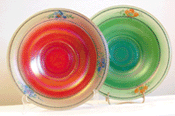
Produced in the '20s, these bowls are clear and iridized, reverse painted in
red/green and hand-painted.
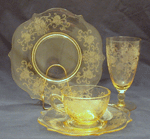
One of two complete dinnerware sets made by Lancaster, 23 pieces. Somewhat
rare Patrick pattern, mold etched and produced in yellow and pink.
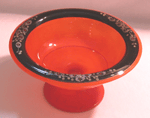
Reverse painted; bright orange compote, a
popular color in the late '20s
and early 30's.
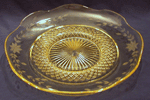
Diamond Band pattern can be undecorated, etched or satinized in clear pink or
yellow, frosted white or yellow.
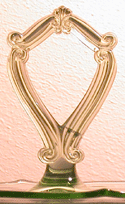
Close-up of the graceful scrolled handle, a trademark design by
Lancaster.
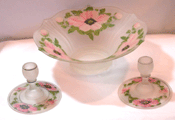
Hazel Weatherman hand-painted flower pattern "Milly", 1932.

This compote is an example of iridized stretch, another technique used to
decorate glass; Iris Ice decoration. This style of flower was used repeatedly by
Lancaster.
|